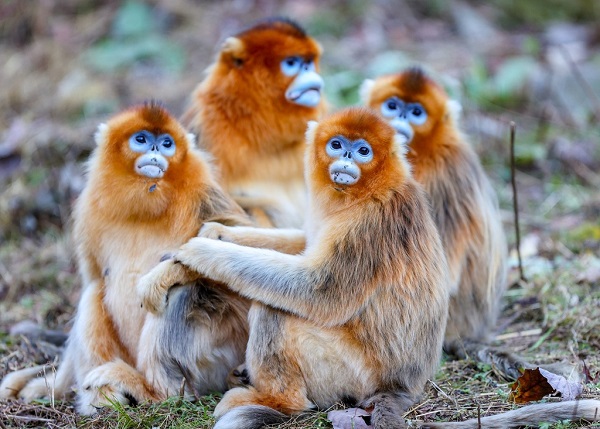Blog 4
Orangutans use both verbal and nonverbal communication. Orangutans use vocal communication in order to express emotions such as fear, aggression, excitement, and to indicate receptivity for mating. The orangutan vocalizations also help build relationships and social organization despite orangutans being semi-solitary.(“HOW DO ORANGUTANS ‘TALK’?”). Despite the high intelligence of orangutans, their communication remains fairly simple.
The common types of orangutan vocalizations are the grunt, scream, kiss-squeak, and grumble. Most of these sounds are observed in females, infants and adolescents, and unflanged males. These orangutans tend to be more social than flanged males. The grunt is a low sound produced by females and immature males. Unflanged males have also been observed grunting to indicate a desire to mate with females. The ‘scream’ sounds exactly like you would expect a scream to sound. Unsurprisingly, the scream is primarily used by infant orangutans when hungry or when they feel upset. The kiss-squeak sound indicates displeasure and is often accompanied by tree shaking to ward off anything perceived as a threat. The grumble is a sound that can only be heard in close proximity and is often produced by females and unflanged males to express annoyance. Some unflanged males also emit a grumble during mating to express pleasure. (“HOW DO ORANGUTANS ‘TALK’?”). ORANGUTAN VOCALISATIONS
The most distinctive sound produced by orangutans is the long call, which is only made by flanged males. Flanged males have a large throat sac that allows them to produce this call that can be heard from a mile away through dense jungle. The long call has been used both as a territorial call and as a way to indicate receptivity to mating. The long call has been studied to be a fairly basic call without a lot of variance.
Orangutans also use basic nonverbal gestures to communicate. They point, wave, and have specific limb motions to indicate wants and needs. The gestures are used to request items, initiate interactions, or to warn others. Researchers have also observed orangutans repeating gestures when they feel they weren't understood. The researchers found out that orangutans repeat or change their indications by pretending not to understand the gestures and giving orangutans foods other than the ones they were requesting. (Safariadm).
Orangutans live semi-solitary lives, with flanged males being the most isolated orangutans. Flanged males' only interaction with other orangutans is often mating with females or fighting with other adult males. The strongest bonds among orangutans are those between mothers and offspring. Young adult orangutans have often been observed traveling back to visit their mothers even after they are fully independent. The only other species observed to have such a strong connection between mothers and their adult children is humans. Because of the increased time spent between mothers and children, this is when a lot of communication occurs. (“Orangutan Foundation International – 97% of Our DNA...100% of Our Commitment! Supporting Conservation and Understanding of Orangutans.Orangutan Foundation International | 97% of Our DNA…100% of Our Commitment! Supporting Conservation and Understanding of Orangutans.”)
Orangutans are recorded to be highly intelligent apes. They have reasonable general intelligence, which means they possess some reasoning ability and cognitive flexibility. There is documentation of orangutans using tools, innovation, and problem-solving. The tool use observed has included rain and sun shelter, tools for scratching themselves, and extracting seeds from hard shells. The slow life history of orangutans also allowed for high amounts of social learning. Their social learning has been observed to result in geographically specific skills. Orangutans' life history and cognitive abilities are similar enough to humans that they have been the subject of study on human/primate cognition. (Damerius et al.).
An orangutan using a spear to fish. (Kamrani).
Sources:
“HOW DO ORANGUTANS ‘TALK’?” N.p., 3 Jan. 2023. Web. <https://www.orangutan.or.id/how-do-orangutans-talk#:~:text=A%20vocalisation%20that%20can%20be,males%20from%20entering%20their%20territory.>.
Safariadm. “How Do Orangutans Communicate?” Taman Safari Bali 6 Mar. 2020. Web. <https://www.balisafarimarinepark.com/orangutans-communicate/>.
“Orangutan Foundation International – 97% of Our DNA...100% of Our Commitment! Supporting Conservation and Understanding of Orangutans.Orangutan Foundation International | 97% of Our DNA…100% of Our Commitment! Supporting Conservation and Understanding of Orangutans.” N.p., n.d. Web. <https://orangutan.org/orangutan-facts/orangutan-behavior/#:~:text=Social%20Organization,with%20adult%20and%20adolescent%20females.>.
Damerius, Laura A. et al. “General Cognitive Abilities in Orangutans (Pongo Abelii and Pongo Pygmaeus).” Intelligence 74 (2018): 3–11. Web. <https://doi.org/10.1016/j.intell.2018.10.008>.
Kamrani, View All Posts by Kambiz. “Orangutan Using Tool to Fish.” Primatology.net. N.p., 29 Apr. 2008. Web. <https://primatology.wordpress.com/2008/04/29/orangutan-photographed-using-tool-as-spear-to-fish/orangutan-tool-use-fishing/>.


Comments
Post a Comment